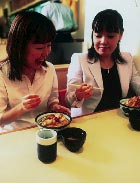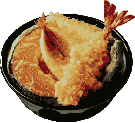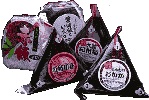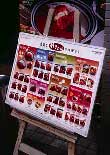
 |
| Fast food in Japan is not limited to McDonald's hamburgers. A variety of Japanese fast foods fulfill the demand to be "fast, cheap, and good tasting." In this issue we introduce those centering around rice. |
Among the leading
Japanese fast foods are dishes with names including the character don
( |
 Yoshinoya website (English): http://www.yoshinoyausa.com/ Photo: Yoshinoya D&C |
|
|
Tempura is seafood or vegetables
deep-fried after being coated in a batter of flour, egg, and water. When
doused with a sweet and tangy sauce and served in a donburi over
a helping of rice, tempura is called tendon. Although a common
meal served at suppertime in homes all over Japan, tempura is also a delicacy
of specialty restaurants, at 5,000 to 10,000 yen per serving. Recently,
however, shops offering inexpensive and high-quality tendon and
tempura have been doing well; it seems even tempura is joining the ranks
of fast food.  |

Tenya's website (Japanese): http://www.tenya.co.jp/ Photo: Ten Corporation |
Today's onigiri (also
called omusubi)--a ball of packed white rice either mixed with
or stuffed with savory condiments and wrapped in a sheet of nori
(laver seaweed)--did not become common until after World War II. The name
onigiri ( |

 Three F's "The Secret to Onigiri" website (Japanese): http://www.three-f.co.jp/special/onigiri/index.html Photo: Hongo Jin |
 Children and adults alike in Japan love kare raisu. Introduced
to Japan in the Meiji era (1868-1912) after passing through Great Britain
from India, today's kare raisu has since undergone a variety
of innovations. The curry, made by sauteing vegetables and meat, boiling
them until soft, and adding a curry roux (a paste made of curry powder
and flour, used to thicken the soup), is poured over a plate of white
rice. Easy to prepare, it is a frequent item on the household dinner table.
Children and adults alike in Japan love kare raisu. Introduced
to Japan in the Meiji era (1868-1912) after passing through Great Britain
from India, today's kare raisu has since undergone a variety
of innovations. The curry, made by sauteing vegetables and meat, boiling
them until soft, and adding a curry roux (a paste made of curry powder
and flour, used to thicken the soup), is poured over a plate of white
rice. Easy to prepare, it is a frequent item on the household dinner table. |
CoCo Ichibanya website (Japanese): http://www.ichibanya.co.jp/ Photo: Ichibanya, Hongo Jin |
  |
|
Original text : The Japan Forum Newsletter no 27 "Japanese Culture Now" December 2002.
Send feedback to forum@tjf.or.jp